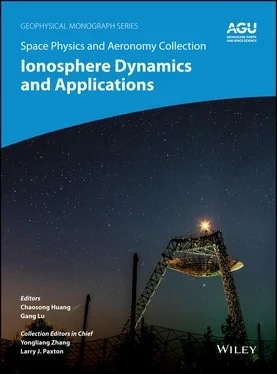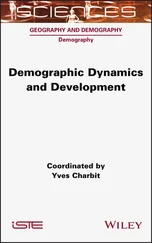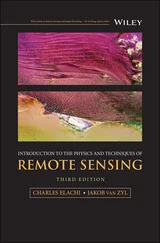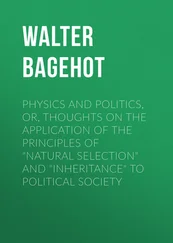Combined, the antisunward and sunward flows associated with the Dungey cycle and the east‐west sense of flows in the dayside polar cap produced by tension forces are clearly seen in the empirical convection patterns presented in Figure 2.1. The cross‐polar cap potential, Φ PC, is largest for southward IMF, when the dayside reconnection rate is largest (e.g., Reiff et al., 1981; Milan et al., 2012, and references therein), that is when the magnetic shear at the subsolar magnetopause is greatest. There is evidence that Φ PCsaturates near 250 kV when driving of the magnetosphere is particularly strong (e.g., Siscoe et al., 2002, 2004; Hairston et al., 2003, 2005); although several models have been proposed to explain this saturation, it has not yet been possible to clearly discriminate between them (e.g., Shepherd, 2006; Borovsky et al., 2009).
2.3.3 Magnetosphere/Ionosphere Current Systems
Electric currents are an integral consequence of the electrodynamic coupling between the solar wind and the magnetosphere, and the magnetosphere and the ionosphere. In the outer magnetosphere, the field lines deviate from a dipolar configuration due to the confinement of the Earth's field by the solar wind (e.g., Fig. 2.2a), and Ampère's law, equation (2.7), indicates that electric currents must flow; indeed, these currents are associated with the j × Bforces (magnetic pressure and tension) discussed earlier. Figure 2.6b shows the Chapman‐Ferraro current on the magnetopause (Chapman & Ferraro, 1931), which provides magnetic pressure to balance the solar wind ram pressure. The magnetic reversal in the magnetotail neutral sheet is also associated with a dusk‐to‐dawn cross‐tail current, which forms current loops with the magnetopause currents.
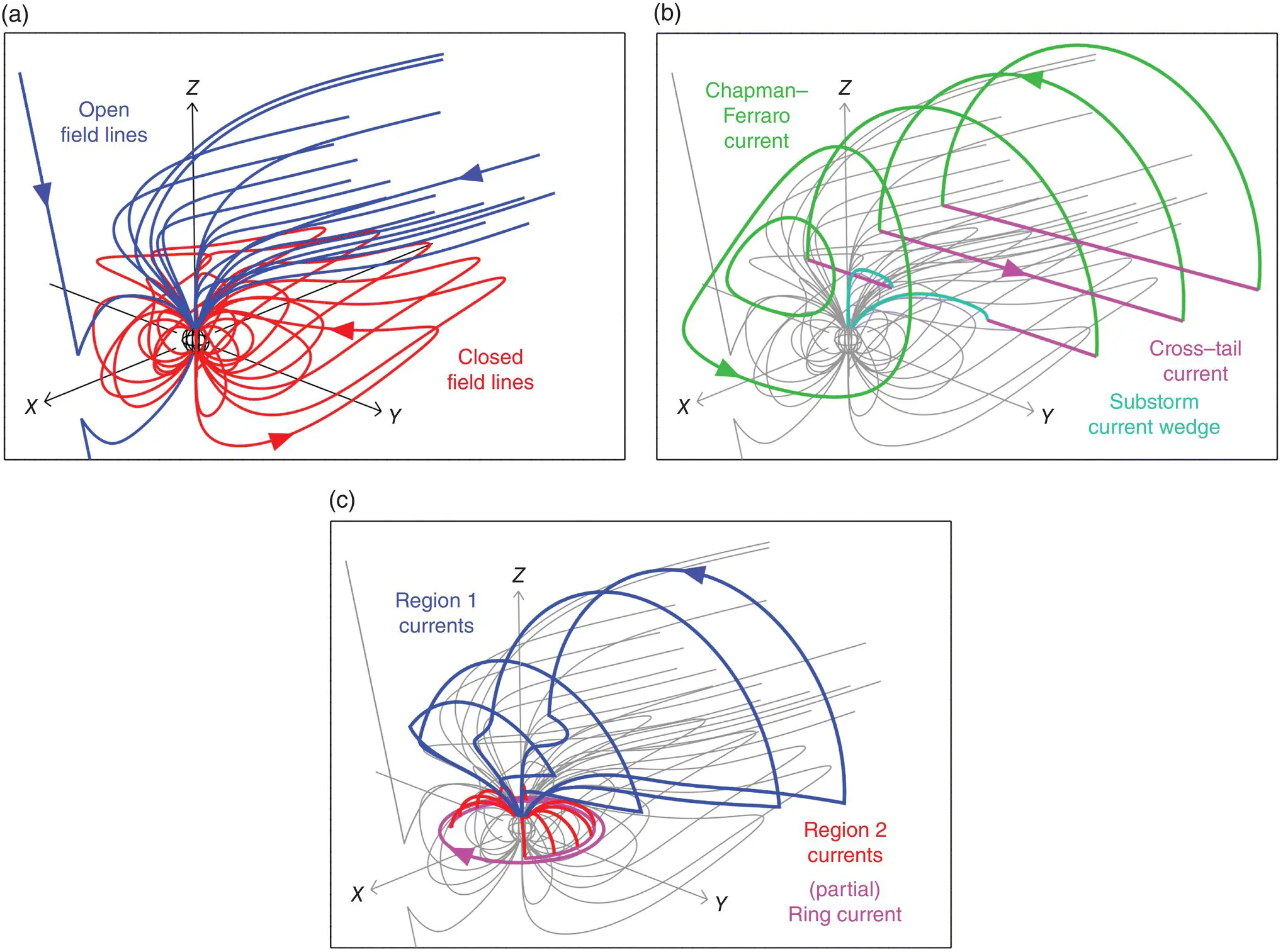
Figure 2.6 (a) A 3‐D representation of the Earth's magnetic field (southern lobe field lines suppressed for clarity); (b) current systems formed by the deformation of the magnetic field by the flow of the solar wind; (c) current systems formed by convection within the magnetosphere (after Milan et al., 2017; Licensed under CCBY).
Currents also form due to the deformation of the field by the Dungey cycle flow in the magnetosphere and its coupling to the ionosphere ( Fig. 2.6c). As described above, ion‐neutral collisions produce a drag on the ionospheric flow. Figure 2.3a sketches the pattern of electric field E, and Figure 2.3b shows the Pedersen and Hall currents that flow in the ionospheric E region in Eand − E× Bdirections as green and orange arrows, respectively. In the polar cap region, where the flow is antisunward, a dawn‐to‐dusk ionospheric Pedersen current is generated. At the magnetopause, a current flows from dusk‐to‐dawn (in the same sense as the Chapman‐Ferraro current), associated with tension forces between the IMF and the internal field (at the kinks in the newly reconnected field lines in Fig. 2.2a). The combined action of these currents and the magnetic perturbations they produce is to cause a bend‐back of the open field lines above the ionosphere, as shown in Figure 2.7b. The kink in the field at the ionosphere is associated with a j× Btension force that acts to balance the frictional drag; the kink at the magnetopause is associated with a j× Btension force that acts as a drag on the flow of the solar wind. These two currents hence transfer momentum from the solar wind to the ionosphere. A similar process takes place in the closed flux, return flow region: sunward‐moving field lines are bent sunward by the drag of the ionosphere; here, the bend‐back is in the opposite sense to that in the polar cap and the ionospheric Pedersen current is similarly reversed to be directed dusk‐to‐dawn ( Fig. 2.3b). In other words, at shears or vorticity in the ionospheric convective flow, there is also a magnetic shear above, between the opposed directions of field bend‐back; again, Ampère's law, equation (2.7), requires that currents flow along the magnetic field lines threading the shear ( Fig. 2.7a and b), fed by the divergence of horizontal currents in the ionosphere. Magnetic perturbations above the auroral zones were first discovered experimentally by Zmuda et al. (1966, 1967), and Cummings and Dessler (1967) identified these as being produced by the field‐aligned currents first predicted by Birkeland (1908). The overall morphology of these FACs was subsequently described more fully by Iijima and Potemra (1976a, b, 1978) (see left panel of Fig. 2.8). They form two concentric rings of FAC, termed region 1 (R1), which maps to the magnetopause, and region 2 (R2), which maps to the inner magnetosphere. FACs also flow in the dayside polar cap associated with east‐west flow asymmetries produced by tension forces when IMF B Y≠ 0. These FACs are shown by circled dots and crosses in Figure 2.3b. On open field lines, the R1 FAC closes across the magnetopause as described above. At the equatorward edge of the return flow region, the R2 FAC connects to the partial ring current associated with the sunward convection of hot plasma sheet plasma described in section 2.3.2.
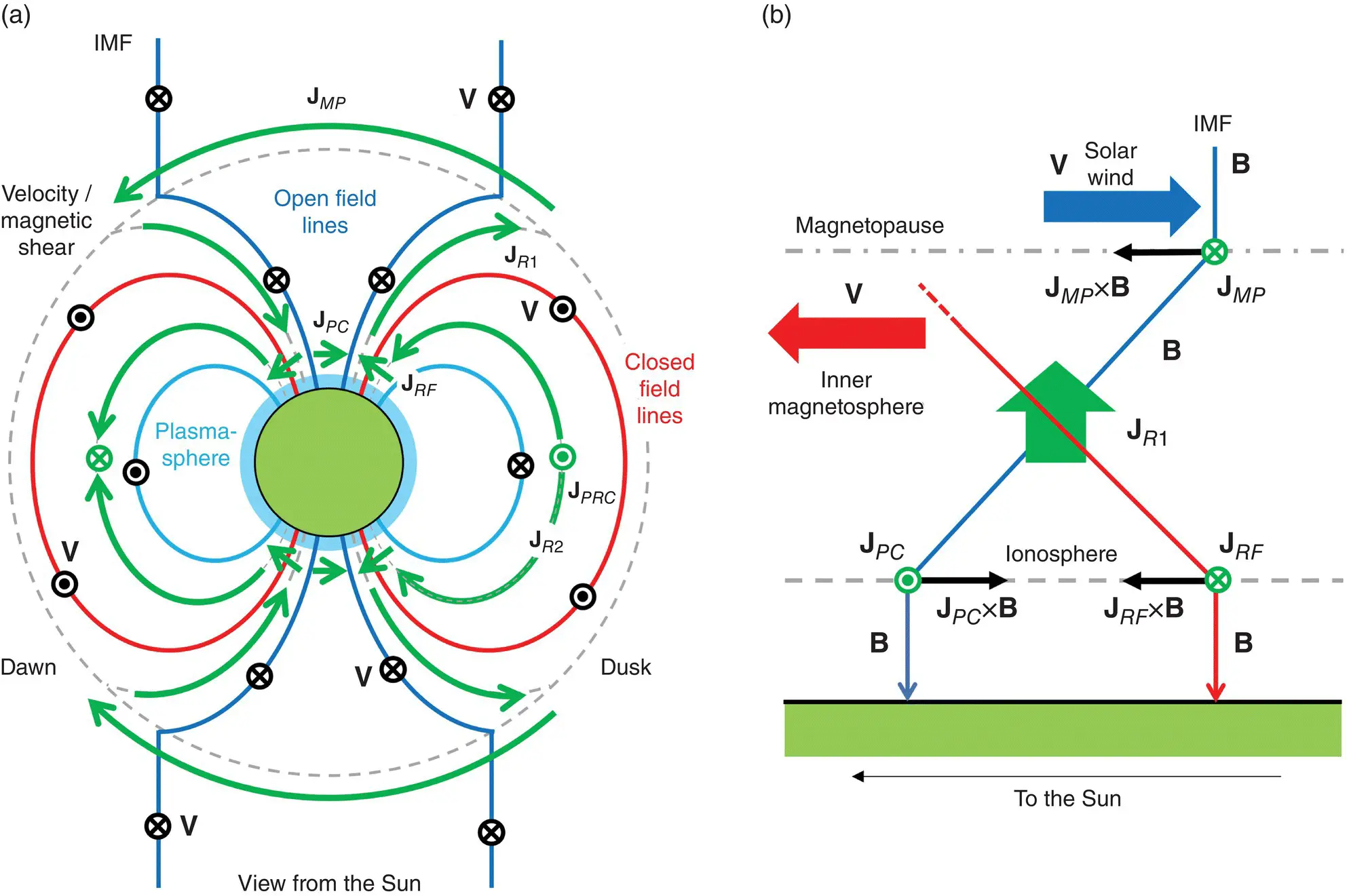
Figure 2.7 (a) A cut through the magnetosphere in the X = 0 plane, showing the sense of plasma flow (black arrows into and out of the page) in the open, closed, and plasmasphere regions, along with the sense of current flows (green) at the magnetopause, ionosphere (polar cap and return flow regions), R1 and R2 FACs, and partial ring current. (b) The deformation of open (blue) and closed (red) field lines by flows in the solar wind and inner magnetosphere and the frictional forces of the ionosphere, and the sense of field‐aligned current produced by the magnetic shear.
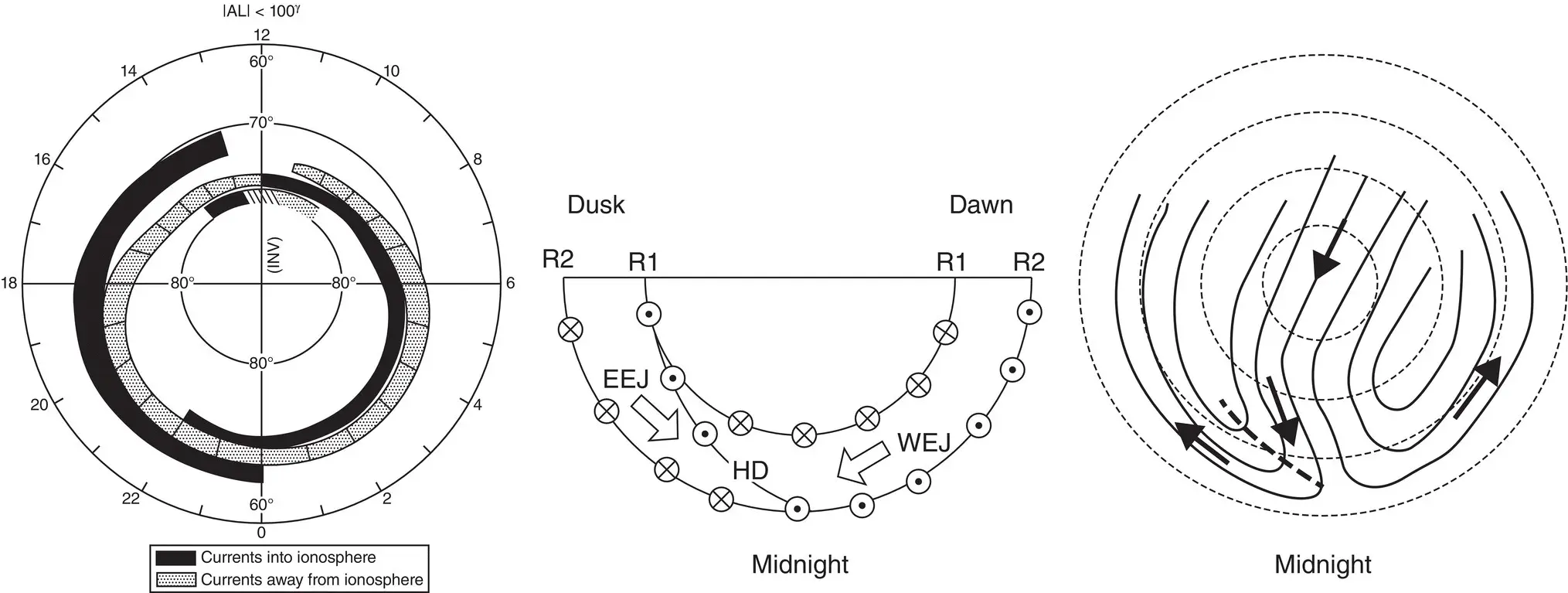
Figure 2.8 (Left) Field‐aligned current pattern associated with vorticity in the convection flow, with black as downward current and grey as upward current. The two concentric rings of FAC are region 1 or R1 (high latitude) and region 2 or R2 (low latitude). The overlap of currents in the premidnight sector is associated with the Harang discontinuity. Upward or downward FAC flows poleward of the dayside R1 FAC depending on the sign of IMF B Y, associated with east‐west flow asymmetries produced by magnetic tension forces on newly opened field lines
(from Iijima & Potemra, 1976).
(Right) The Harang discontinuity as seen in FACs and convection
(adapted from Iijima & Potemra, 1976; Koskinen & Pulkkinen, 1995).
The magnitude of the FACs can be found from the divergence of J ⊥by combining equations (2.6)and (2.10):
(2.14) 
in which the three terms on the RHS are the divergence of J Pdue to shears in the convection flow, the divergence of J Pdue to gradients in the Pedersen conductance, and the divergence of J Hdue to gradients in Hall conductance. In the limit of uniform conductance, this reduces to Poisson's equation. The distribution of FACs can then be compared with or inferred from the vorticity in the convective flow (e.g., Sofko et al., 1995; McWilliams et al., 1997; Green et al., 2006; Chisham et al., 2009). In the auroral zone, with a Pedersen conductance of 10 S, a flow speed of 500 m s −1produces an ionospheric current across the flow of 0.25 A m −1. If the convection reversal associated with the low‐latitude duskside flow shear is 2,000 km in length, then 0.5 MA of FAC flows in the R2 current there. The R1 current poleward of this will be of a similar magnitude, possibly enhanced somewhat by a contribution from Pedersen current flowing across the polar cap, as shown in Figure 2.3b (though see Laundal et al., 2018, for a discussion of horizontal current closure). By this estimate, it is expected that when convection is ongoing, approximately 2 MA flows into and out of the ionosphere in each hemisphere in the whole R1/R2 system, increasing during periods of strong driving, in agreement with the observations of Iijima and Potemra (1978).
Читать дальше
